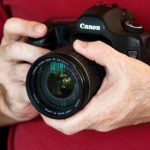By: Sarah Parlin
 Many new digital and film photographers normally have a problem known as “camera shake” where they produce blurry images mostly because they do not hold the camera still enough while depressing the shutter. This is highly common with shots that are taken when the shutter is open for a long time and taken in low light situations. This can be caused when the camera is moved slightly and the only way this can be resolved is to use a tripod.
Many new digital and film photographers normally have a problem known as “camera shake” where they produce blurry images mostly because they do not hold the camera still enough while depressing the shutter. This is highly common with shots that are taken when the shutter is open for a long time and taken in low light situations. This can be caused when the camera is moved slightly and the only way this can be resolved is to use a tripod.
In addition to the camera shake, another technique that is common with people who use digital cameras is holding it at arm’s length with one hand when taking the shots. While this may look like a great way of taking shots, it also increases the chance of shaking or swaying while taking the shot.
To stop the camera from shaking, it is highly recommended that you use a tripod as this comes with 3 sturdy legs to ensure all the shots are still. If you cannot find it, you can also hold the camera with both hands to improve stability. While it may seem easier to take a shot with one hand, using both enhances stillness the same way getting a tripod with three legs is better than one with 2 legs.
The type of digital camera you are using plays a huge role on the grip you will have on it. There is really no wrong or right way to do this but below you will find a routine that is generally acceptable.
Your right hand should grip the right end of the digital camera. The forefinger should lightly sit above the shutter release while the remaining fingers should curl around the front of the device. Use the right thumb to grip on the back of the camera. This should actually feel natural as nowadays cameras come with some impression and a kind of grip. Use a strong grip but not one that is too tight as this may shake the device. Also remember the squeeze the shutter instead of jabbing at it.
Image source: http://digital-photography-school.com/how-to-hold-a-digital-camera/
Where the left hand will be placed depends on the camera in use but it should be done in such a way that it supports the weight of the camera. It can sit around/under the lens or underneath the camera. When using a DSLR, place the camera close to the body as this enhances stability but if you are shooting with an LCD, do not hold it too far away from you. Your elbows should be tucked on the sides and the camera should lean out in a way that it is away from the face. The viewfinder may also be used see though especially if it is not too small and can be used with ease.
If you don’t have a tripod with you, you can use something to support the camera to help minimise camera shake. Image source: http://www.beaulieucameragroup.co.uk/useful%20information.htm
As above, you can also lean against a solid place like a tree or wall or even kneel or sit as this helps to improve stability. When this is not an option, your feet shoulder should be wide apart as this helps to give you a steady stance. Try and keep the body as still as possible as this also ensures that your camera remains still. When you hold the camera this way, you will be flexible enough to line up various shots fast and it will also ensure that you are ready for the important moment when the shutter opens.
Taking a gentle but deep breath is another tip you can work with before holding the camera. Here you are supposed to hold your breath, take the shot and finally exhale. There are some people who attest to the opposite where you are supposed to exhale and take the shot before inhaling again. You will be amazed by how the body falls and rises by breathing and being conscious of this can give you the edge needed.
It is worth considering the above techniques especially when you are starting out before you familiarize yourself with the camera and get the position that you are most comfortable with and works out well for you. When you hold your camera right, you can be assured that you will not have to worry about blurry images. Other techniques that can be used with the above include using lenses with image stabilization; shutter speeds and tripods can help out when it comes to decreasing camera shake.
